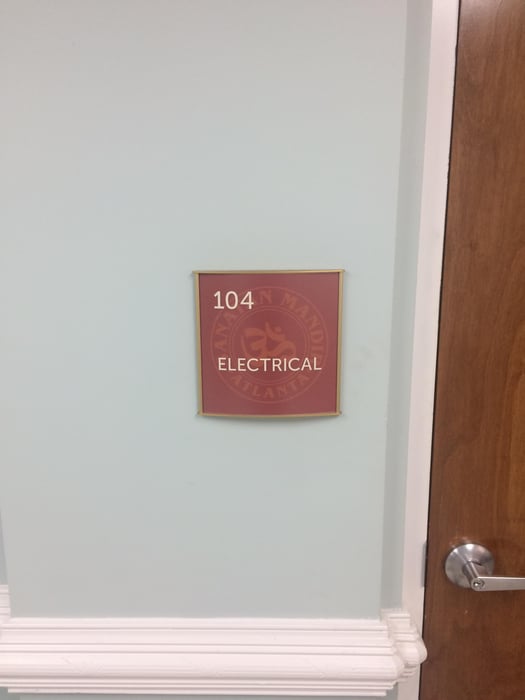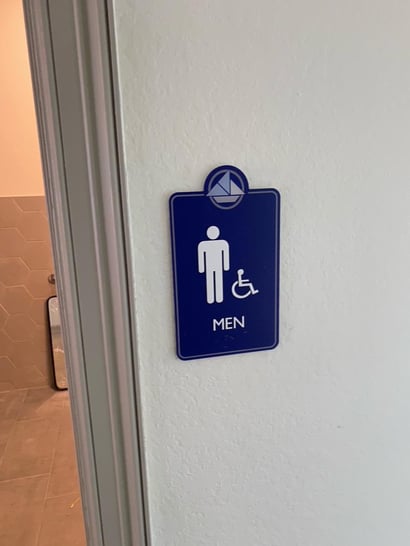ADA signage is an essential part of ensuring accessibility and compliance for individuals with disabilities. Effective ADA signage allows individuals with disabilities to navigate and access public buildings with ease, ensuring their safety and inclusion. In this blog post, we’ll explore some tips for creating effective ADA signage that maximizes accessibility and compliance.
Understand ADA Guidelines and Requirements
The first step in creating effective ADA signage is to understand the guidelines and requirements set forth by the Americans with Disabilities Act (ADA). These guidelines specify the size, placement, and design of signage to ensure maximum accessibility for individuals with disabilities. It is important to ensure that your signage is compliant with these guidelines to avoid any legal issues and to ensure the safety and accessibility of individuals with disabilities.
ADA Braille Sign with Custom Background
Use High Contrast Colors and Legible Fonts on ADA Signs
Using high contrast colors and legible fonts can improve the readability and visibility of your ADA signage. The ADA guidelines recommend using high contrast colors between the background and text to ensure that the text is easily readable. Additionally, using clear and legible fonts can make it easier for individuals with visual impairments to read the signage.
Include Braille and Tactile Elements on ADA Signs
Including braille and tactile elements in your ADA signage is critical for ensuring accessibility for individuals with visual impairments. The ADA requires the use of braille and tactile elements in certain types of signage, such as restroom signs, exit signs, and room identification signs. It is important to ensure that these elements are placed in a consistent and accessible location to ensure maximum accessibility for individuals with disabilities.
ADA Shower Sign with Pictogram.jpeg?width=534&height=712&name=ADA%20Signs%20(9).jpeg)
Ensure Proper ADA Sign Placement and Visibility
Proper placement and visibility are crucial for effective ADA signage. The ADA guidelines specify the placement and height of signage to ensure that it is easily visible and accessible to individuals with disabilities. It is important to ensure that signage is placed in a consistent location throughout the building to ensure that individuals with disabilities can easily find and navigate their way around the building.
Using Pictograms on ADA Signs
Pictograms are a type of universal symbol that can be easily understood by individuals regardless of their language or reading ability. Including pictograms in your ADA signage can improve accessibility and understanding for individuals with disabilities. The use of pictograms can also help to eliminate potential barriers that may arise due to language or cultural differences.
ADA Stairs Sign with Tactile Image.jpeg?width=574&height=765&name=ADA%20Signs%20(1).jpeg)
Design ADA Signs for Durability
ADA signage is often subjected to wear and tear over time, so it is important to design signage that is durable and long-lasting. Using high-quality materials and designing for durability can ensure that your signage remains effective and compliant over time.
ADA Braille Sign with Custom Logo
Effective ADA signage is critical for ensuring accessibility and compliance for individuals with disabilities. By understanding the guidelines and requirements set forth by the ADA, using high contrast colors and legible fonts, including braille and tactile elements, ensuring proper placement and visibility, using pictograms, and designing for durability, Marietta Signs will create effective ADA signage for you that maximizes accessibility and compliance. With effective ADA signage, you can ensure the safety and inclusion of individuals with disabilities and create a more accessible and inclusive environment for all. Contact us for more information and start your journey to great ADA Signs. CustomerService@MariettaSigns.com or 770-435-4141.
.jpeg?height=420&name=ADA%20Signs%20(9).jpeg)

